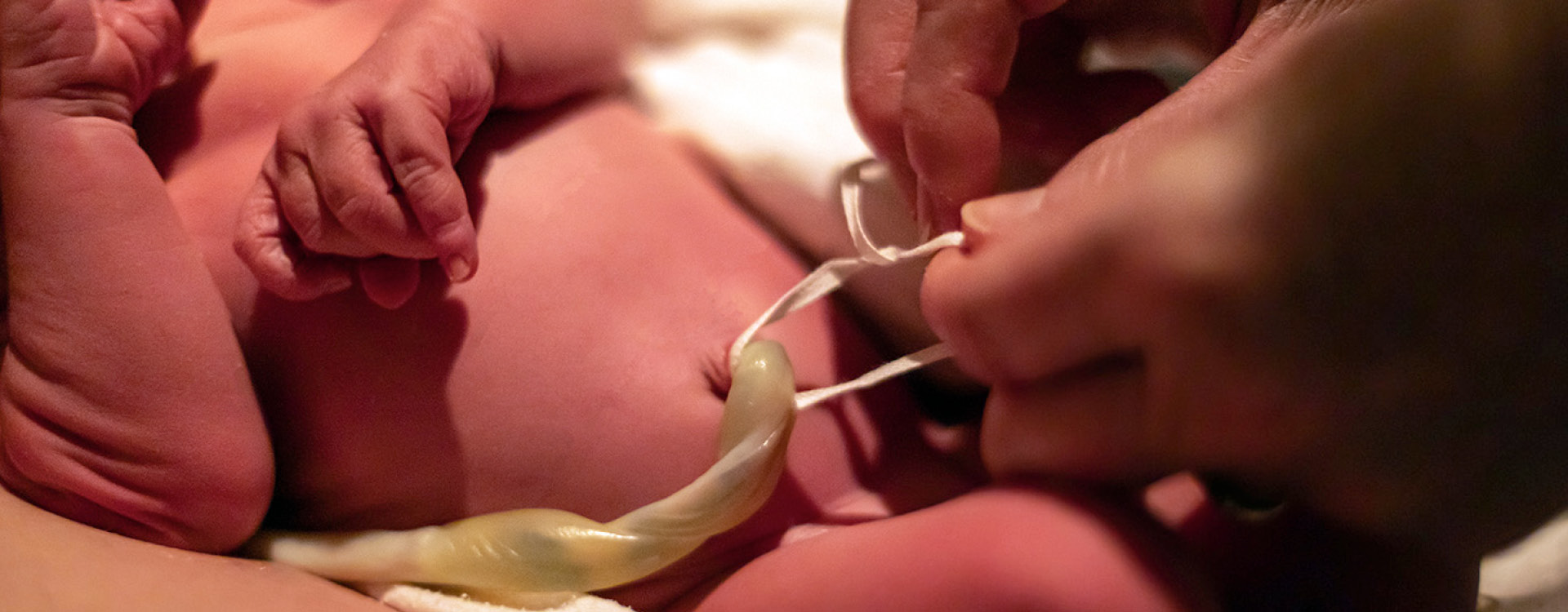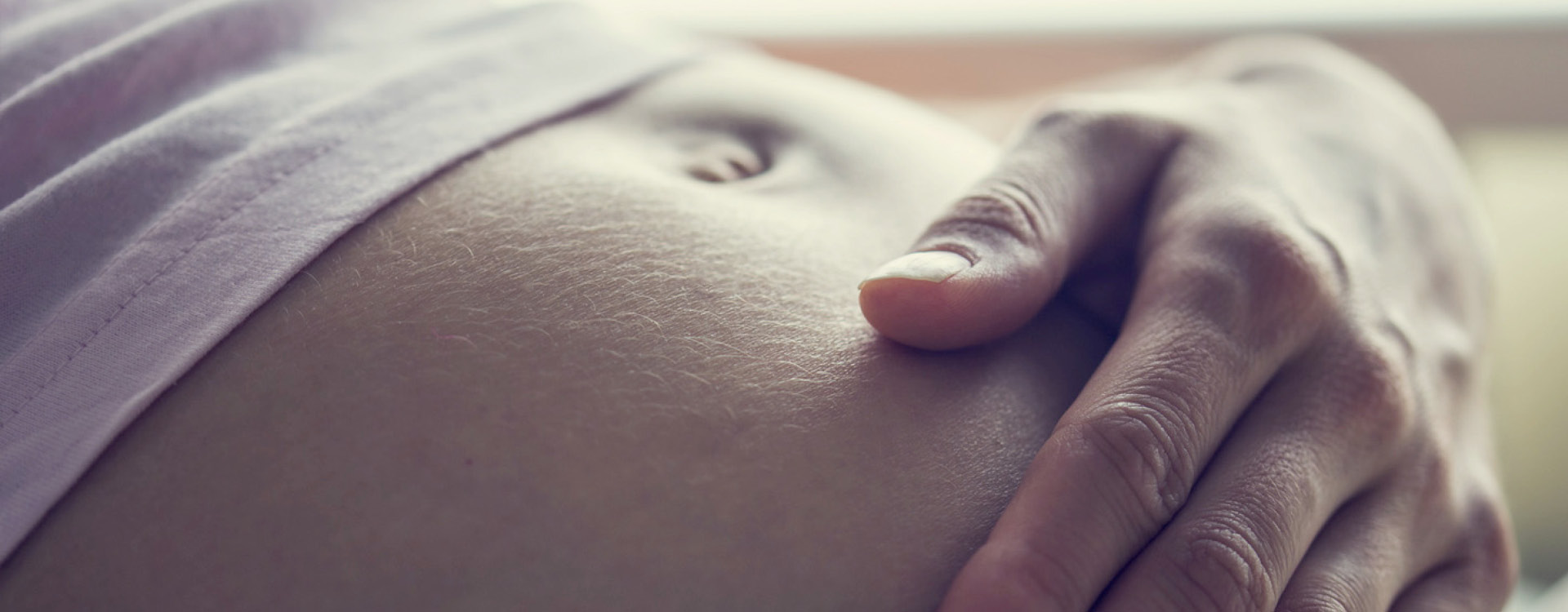There’s nothing quite like the sweet smell of a newborn baby. But a newborn baby still attached to a dead and decomposing placenta in the week or so after birth? Not so much.
Like placentophagia (eating the placenta), Lotus birth is a fringe birth practice gaining in popularity, despite being associated with serious neonatal infection and a lack of evidence as to its purported benefits.
So why do some women want to leave their precious infants attached to a rotting organ? What do they hope to achieve? Are they putting themselves or their babies at risk? Is it even “natural”? Let’s dive in.
What Is a Lotus Birth?
Umbilical nonseverance, colloquially known as Lotus birth, is the practice of leaving the placenta attached to your infant in the days after birth, until the umbilical cord dries up and falls off by itself. This can take anywhere from 3-15 days [*].
The name Lotus suggests this practice has its roots in something like Ayurvedic medicine, or in the superstitious cultural practice of some third world tribe. But no.
Lotus birth is named for Claire Lotus Day, a Californian who in 1974 decided to keep her placenta attached to her baby after birth because she was under the impression that chimpanzees do it. She was not a doctor or midwife or scientist. Apparently, Ms. Day wasn’t a primatologist either, or she would have known that chimpanzees most often eat their placentas as a practical matter or for nourishment. It’s not hard to see how dragging a bloodied organ through the jungle still attached to your vulnerable newborn might be a recipe for attracting predators [*][*].
Nevertheless, Ms. Day found an OBGYN amenable to her request and took her infant son, Trimurti, home from the hospital where she had delivered him with his cord and her placenta in tow [*]. Some accounts note that she observed that her baby seemed more content than if the cord had been clamped and cut in the minutes after birth, but you have to ask yourself, how could she possibly know?
What began as Ms. Day’s desire to mimic chimpanzees for a presumed health benefit to her son became imbued with a great deal of spiritual mumbo jumbo. The practice spread in the U.S. via Jeannine Parvarti Baker, a midwife, anti-circumcision activist, and yoga teacher. In Australia, it spread via midwife Shivam Rachana, founder of the International College of Spiritual Midwifery, as well as self-styled birth guru and GP Dr. Sarah Buckley, who advocates frequently (though unscientifically) in support of natural childbirth practices [*].
It’s hard to say how many women actually practice Lotus birth, but it has been seen in the U.S., U.K., and Australia, as well as Italy and Turkey [*].
How Does a Lotus Birth Work?
Proponents of the practice describe the umbilical nonseverance protocol as follows [*]:
-
Leave the cord intact once the baby is born. If the cord is around the baby’s neck, simply lift it up and over.
-
Place the baby skin-on-skin on the mother while the placenta is spontaneously (without oxytocin) delivered.
-
When the placenta is delivered, put it in a bowl beside the mother.
-
Before handling the placenta to ensure it is intact, wait for the full transfusion of blood to the infant.
-
Gently wash and dry the placenta, then place it in a colander for 24 hours to allow drainage. (It’s hard to say how this would be done in a hospital setting.)
-
Wrap the placenta in absorbent material and place it in a placenta bag. Alternately, lay the placenta on a bed of sea salt and liberally cover it with salt.
-
Whichever method you choose, the cloth covering or sea salt must be changed daily. Do not use a plastic container as this will enhance decay.
-
Take care holding and feeding the baby so as not to pull on the cord.
-
Dress the baby loosely with clothing that opens in front.
-
Bathe the baby as normal but make sure to keep the placenta dry. The cord can get wet, as it will dry again quickly.
-
Avoid traveling with your baby while the cord is still attached.
When to Seek Medical Care
While there are no practice guidelines for Lotus birth from any U.S. medical or clinical organizations, there are known risks of infection. Parents who choose Lotus birth should be aware of these infection red flags. Get your baby to a hospital immediately if they:
-
Have swelling, redness, or warmth around the umbilicus.
-
Have a fever of 100.4 or greater.
-
Are sleeping more than usual.
-
Are feeding poorly (at 1-2 days of life, there should be 6-8 feedings and 2 urines and 2 stools; at 2-3 days of life, at least 8-12 feedings per day and 3 urines and 3 stools) [*].
Doctors also advise against cutting the cord yourself after you get home due to the risk of serious infection. And if you do decide to travel with your baby, they must still use an approved car seat. If need be, you can moisten the cord with gauze and water to soften and reshape the cord to fit under or over the car seat’s buckle [*].
Lotus Birth Purported Benefits
There is no evidence to support any of the purported benefits of Lotus birth, with the exception of the added blood volume an infant could also experience with delayed cord clamping.
Back in 1974, when Claire Lotus Day was having her baby, there was a resurgence of interest among researchers in the benefits of delayed cord clamping and physiological cord clamping (waiting until the pulsations in the cord cease before clamping and cutting).
In infants carried to term, delayed cord clamping improves neonatal oxygen transport and red blood cell flow and in premature infants, it is associated with fewer days on oxygen and ventilation. Studies have shown better outcomes for brain development and motor skills in the first year of life [*].
While the ACOG and other clinical and medical organizations recommend delayed cord clamping for at least 30 seconds, some studies argue that the optimal timing to maximize blood flow from the placenta is relative to the infant’s physiology — especially their breathing — versus a stopwatch approach [*].
Because infants can get the same (and better) health benefits from studied, commonly practiced techniques like delayed cord clamping and physiological cord clamping, the reasons people choose Lotus birth boils down to:
-
They think it is a more natural approach to childbirth and that natural is better.
-
They assign a spiritual meaning to the cord and placenta.
-
They believe a more gentle separation from the placenta calms the infant.
-
They think the placenta has more to give the infant.
Let’s look at these claims more closely.
Is Lotus Birth More Natural?
It depends on how you define “natural”.
If natural means no medical intervention, then you could call Lotus birth more natural. (Although Claire Lotus Day actually gave birth in a hospital.)
If natural means according to nature, and millennia of evolutionary biology, the answer is no. Anthropoid apes (chimps, orangutans, gorillas) have been observed to deal with the placenta and cord in different, idiosyncratic ways. In some cases, the cord rips during birth without help from the mother, or the mother separates the cord and eats the placenta [*].
And remember, just a few years ago, Internet bloggers urged women to eat their placenta based on the notion that other mammals (including primates) do. Now they’re talking out of the other side of their mouths, claiming that chimps keep the placenta attached to the infant, so humans should, too. Monkey see, monkey skew!
In “primitive” cultures, the cord may have been left attached for several hours after the placenta delivered [*]. While the timing of cutting the cord has changed throughout history, there is no evidence that ancient cultures ever practiced umbilical nonseverance. (There’s also no evidence human mothers in any world culture ever ate the placenta [*].) The first records of cutting the cord before the delivery of the placenta date back to the 17th century. Lotus birth dates back to 1974.
Is There a Spiritual Meaning to the Placenta?
In many cultures throughout history, yes, the placenta is revered as a living being, a spiritual twin. From setting it out in a boat with tiny lights at night to be eaten by crocodiles to being carried into battle to confer warrior-like benefits to being made into face creams, the placenta has fascinated humans for centuries and many rituals surround it [*].
But you can also see how the medical establishment would view the placenta as medical waste after delivery. Yes, it sustained the infant in the womb, but it also filtered toxins from the infant. It was subject to all the bacteria of the mothers’ genitourinary tract on its exit from the womb, may have collected bacteria floating around the hospital or from the applied preservatives, cloth or salt, and was touched by many caregivers’ gloved or ungloved hands.
Does Lotus Birth Calm the Infant?
Lotus birth proponents suggest that the baby can somehow feel the cord being cut and this causes some kind of lifelong psychological trauma. But there are no pain receptors in the cord and neither the mother nor the baby can feel it being cut. Further, no fetal stress has been revealed when the umbilical cord is punctured during in utero procedures [*].
Australian GP Dr. Sarah Buckley writes, “I notice an integrity and self-possession with my lotus-born children, and I believe that lovingness, cohesion, attunement to Mother Nature, and trust and respect for the natural order have all been imprinted on our family by our honouring of the placenta, the Tree of Life. [*]”
In other words, the evidence here is strictly anecdotal. You can understand why parents would want to ease an infant’s transition from the calm of the womb to the chaos of the world we live in, but there’s no reason to believe Lotus birth actually does that.
Does the Placenta Have More to Give After Being Delivered?
The placenta is truly an astonishing organ, serving two masters independently. But once it has been delivered, in the absence of blood flow from the mother, its tissues become necrotic. Without blood supply from the mother, the placenta is nothing more than a dead and decaying organ attached to your infant. The only thing it can give your infant is a life-threatening infection.
Lotus Birth Risks
To say that the detached placenta is a playground for dangerous bacteria is understating the case. The placenta could not only contaminate the infant via the blood in the cord, but it could also spread infection to other babies, siblings, or immune-compromised grandparents.
As a practical matter, it seems untenable. Having to touch it daily to clean it and move it along with your baby would likely enhance the risk of spreading bacteria to it and from it. Keeping it aired out to mitigate the rot also means more bacteria can join the party.
You have to ponder the wisdom of placing a culture medium potentially carrying staphylococcus (or whatever the cat or dog had in their mouths when they had a lick of it when you weren’t looking) so close to a vulnerable newborn with a delicate immune system.
There aren’t a lot of studies on Lotus birth and there probably will never be because it is a high risk, no-benefit practice that researchers are not keen to legitimize. There are reports of infants who suffered no ill effects from Lotus birth (and also no proven benefits). But there are also some alarming case reports of infants who suffered from Lotus birth or overly delayed cord clamping, for example:
-
Hypovolemic shock - An infant’s cord was not clamped until 50 minutes old and the placenta was placed below the level of the infant during this time. The infant was born full-term and vigorous but lost a large volume of blood back into the placenta because the cord was not clamped, leading to hypovolemic shock [*].
-
Omphalitis with e coli bacteremia and urinary tract infection - A child born healthy developed a serious infection of the umbilicus (omphalitis), which was still attached and showed swelling and redness. Omphalitis is a dangerous condition with a mortality rate of 7-15%. The parents brought the infant back in after 3 days, requesting his cord be cut. The infant survived after nearly a month of antibiotics administered in the hospital [*].
-
Idiopathic neonatal hepatitis - A baby born spontaneously at home with the cord left attached to the placenta was brought to a hospital after 72 hours due to jaundice, lethargy, poor feeding, and a slight fever. His cord was cut and he was treated, leaving the hospital healthy again after 4 days, but he returned again with the same symptoms at 25 days old. Doctors attributed his condition to mildly elevated liver enzymes that may have been the result of infection from leaving the cord attached, the non-sterile home birth environment, or a combination of the two. This condition persisted until the baby was 18 months old [*].
These parents wanted to give their babies a head start in the world, a calm and gentle entrance, without cutting the cord. But in the end, their babies got 10 times the medical intervention they would have had if they’d simply cut the cord. And it saved their babies’ lives.
Lotus Birth Considerations
It’s possible that parents who opt for Lotus birth are so focused on the spiritual aspects of it that they can’t conceive of the risks. Among unassisted birth networks, the feeling is that the vast majority of childbirth problems are inflicted, rather than prevented, by doctors [*].
The ACOG has issued guidelines to minimize medical interventions in normal pregnancies [*], but at the same time, the number of normal pregnancies that turn into pregnancies with complications and high-risk situations during labor is rising.
Severe maternal morbidity — unexpected outcomes of labor and delivery that significantly compromise a mother’s short- or long-term health — increased 200% between 1993 and 2014. Studies say 60% of the deaths in pregnancy occurring between 2013-2017 were potentially preventable [*].
The rise in the need for medical interventions in pregnancy and labor may be attributed to the fact that more women are entering pregnancy with pre-existing conditions like hypertension, type II diabetes, and diagnosed obesity.
A 2020 Blue Cross Blue Shield report studied 1.8 million pregnancies among insured women between 2014 and 2018. The number of women with both pregnancy complications and childbirth complications increased 31.5%. Women with pregnancy complications are twice as likely to have complications during childbirth. Perhaps unsurprisingly, postpartum depression increased almost 30% in this time period [*].
What Experts Say About Lotus Birth
Medical experts agree that Lotus birth is not a natural practice based in some ancient wisdom or evolutionary biology, it has no proven benefits, and it’s not safe.
As Dr. Jennifer Gunter, Canadian-American OBGYN, women’s health expert, and author writes [*]:
A 'lotus birth' is biologically unsound, untested, and real harm to babies has been described. It is the equivalent of diapering up a raw steak and attaching to your newborn for three to five days. It is not a magical, historical or cultural practice forcibly torn away from women by an uncaring patriarchy[,] it was something a woman dreamed up after hearing about chimpanzees. To brand this as a modern ritual is nothing but predatory marketing.
Gunter goes on to wonder how parents can disbelieve “the risk of leaving a dead placenta attached to their baby but would never drive their newborn without a car seat.”
Dr. Amy Tuteur, an OBGYN, former clinical instructor at Harvard Medical School, and author, believes the trend toward Lotus birth isn’t even about giving your baby a good start in life:
What’s the real reason behind lotus birth? Homebirth and other fringe birth advocates are engaged in a battle of one-upsmanship, and the woman with the most bizarre (and often the most dangerous) birth practices wins.
Can You Save Cord Blood With a Lotus Birth?
No, you cannot save cord blood with a Lotus birth. Cord blood and tissue is a powerful ally for your infant and family. There are more than 80 FDA-approved treatments using cord blood stem cells for heritable blood disorders and diseases, and more than 300 clinical trials in progress.
MiracleCord offers industry-leading technology and cord blood storage that’s easy and affordable for families that want added protection from the unknown for their infants and their siblings.
Call 888.743.2673 to have your questions answered by a knowledgeable customer service representative, or download our Free Info Kit.
The Bottom Line
There’s a lot of concern among natural birth advocates about the increasing medical interventions surrounding birth, whether it’s hormones to move the process along, pain management like epidurals, or even the disturbing trend toward elective c-sections. And it’s easy to believe that a for-profit medical system may be more inclined to intervene.
But you have to remember how many millions of women died in natural childbirth throughout the centuries when all they had were prayers, poultices, and people ill-equipped to handle the complexities of obstructed births, infections, and hemorrhaging [*][*].
With birth complications on the rise, the medical community is struggling to find ways to counsel parents exposed to unsafe, unnatural “natural” birth practices like Lotus birth and placentophagy when those parents have been conditioned online by celebrities and influencers to view the medical establishment with a jaundiced eye when it comes to birth.
In the final analysis, every mother must determine for herself how she wants to experience birth while considering her health and that of her infant. But no one should feel shamed into going it alone or endangering their child because of pseudoscience presented on the internet.
DISCLAIMER: THE INFORMATION ON THIS WEBSITE IS NOT INTENDED TO BE USED AS MEDICAL ADVICE.The materials and information contained on the MiracleCord website is provided for educational and informational purposes only, and is not intended to, and does not constitute, medical or other health advice or diagnosis, and should not be used as such. You should not use this information to diagnose or treat a health problem or disease. If you are seeking personal medical advice, you should consult with a licensed physician. Always consult with a qualified health care provider regarding a medical condition.




